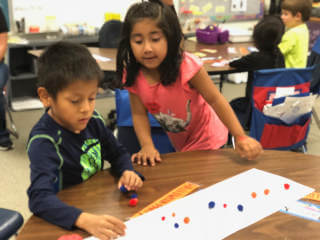Giving students a chance to speak, listen, read and write about a topic is an effective way to make sure they learn the topic. Integrating the four domains of language or four skills is critical to helping students develop content and language fluency.

Notice how the authors of the SIOP (Sheltered Instructional Observation Protocol) Framework want the teachers to again reflect on how to integrate content and language in their lessons. The first part of the feature deals with content (lesson concepts) and the second with language practice opportunities (using one of the four domains of language).
What's interesting and bears mentioning is the first two features of the SIOP component Lesson Preparation deal with language and content as separate objectives (SIOP Feature #1: Write clear content objectives; SIOP Feature #2: Write clear language objectives)

The fact of the matter is students need both language and content. They need the language to be able to interact with the content, and they need the content to be able to make the language tasks meaningful.
Moreover, teachers have little extra time to devote to pure language practice without squeezing a little content practice in there.
Integrating the language and content not only makes it more effective for the learner, it also makes it more efficient for the teacher.
Integrating language and content practice makes learning more effective and efficient. It also helps students develop skills in speaking, listening, reading, and writing.
Students typically have strengths in some skills (or language domains) and possess challenges in others.
Considering the four domains of language and which one(s) students will use when interacting with the content is an important part of setting students up for success.
Teachers who successfully integrate language and content in the classroom find their students learn more efficiently and effectively.
Here are a smattering of ways teachers can integrate language and content in the classroom.
What makes SIOP (Sheltered Instruction Observation Protocol) unique from all other teaching/learning frameworks is its emphasis on language development and the integration of language into all aspects of content instruction in the classroom. SIOP feature #6, Plan meaningful activities that integrate content and language, encourages teachers to set themselves and their students up for success by planning for this very strategy.
TESOL Trainers has been offering SIOP professional development to K-12 educators in the USA and around the world for almost 20 years.
Whether your staff needs an overview of SIOP, an in-depth look at Sheltered Instruction practices, or a targeted workshop on one specific SIOP feature/component, TESOL Trainers has the professional development program for you.
All of our K-12 staff development programs in SIOP are experiential, engaging, and empowering.
We inspire teachers to reach for higher levels of competence in the classroom.
If you want to help your teachers reach the next level in their own skill set, contact John Kongsvik, director of TESOL Trainers, to learn how.
Our online PD can help K12 teachers understand how to integrate the four domains of language to support content and language development.
TESOL Trainers gives educators an experiential look at model lessons, practical techniques, and supportive strategies that set all students up for success.
Teachers appreciate how engaging our PD is and how inspiring it is. Remote teaching and learning offer many challenges to teachers and learners alike. Our remote PD can help teachers assess how they approach teaching and can give them tools to transform how they design and deliver lessons in online, hybrid, and traditional formats.
Contact John Kongsvik for more information on how TESOL Trainers can inspire your teachers in meaningful ways.
Enter your email below to claim your free ebook and join our mailing list.